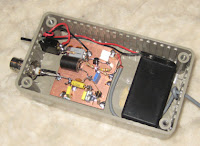This morning I did some more tests using my little 136.93kHz 2W QRSS3 beacon feeding into the 20m spaced earth electrodes. The TX end was unchanged, but this time on receive I used my 30t 80cm loop resonated with about 700pF and fed straight into the high impedance input of my E-field probe. Results were as follows:
- At 2.4km good copy by ear (12wpm CW would have been very solid)
- At 8.6km good copy using Spectran
- At 14.9km clear copy of my callsign and locator in QRSS3 with Spectran on the Gog Megog Hills near Cambridge (see screenshot)
All these locations are more or less in the line of the earth electrodes that run NE-SW from the home QTH (JO02dg). Another RX test some 11km to the south of the QTH resulted in no visible trace, suggesting the TX earth electrodes are behaving as a loop antenna with some directionality. This was not the case when the same earth electrodes were used at 0.838kHz some weeks ago and when the mode was mainly conduction through buried utilities. Remember, this is ultra
simple stuff:
- 2W out crystal controlled QRP 136kHz beacon TX on a 5 x 5cm board (see picture)
- Invisible ground "antenna" that can't be seen, even when a few metres away from it.
- No attempt to match the TX to the earth electrodes.
- Simple loop + FET impedance matching circuit and deaf FT817 at the receiver end.
It would be interesting to work out what the ERP must be and interesting to speculate what would happen with such a system at 73kHz. Pity there is no allocation there today.









